


NOLA VIPER - REFERENCE MODEL
Price: $12,000 per pair in Piano Rosewood
$13,200 per pair in Piano Black
"THIS IS MY QUEST..."
or
To Dream a Possible Dream
For two years I’d been looking for a good pair of speakers to replace my old DCM Timeframe 700’s. The things I liked about the Timeframes were their coherence,soundstaging and surround like imaging. I had hung onto them for as long as I could, but I needed more. More of all the things I liked about the ‘ole DCM’s with the addition of all the things they were lacking. I also needed a suitable reference speaker that would easily reveal the positives and negatives of all the wonderful components I get to review here at the Mojo - a speaker that would tell me the truth and be musical about it.
My quest began with the Angstrom Obbligato’s, a Canadian speaker using a Focal tioxid tweeter, doubleKevlar mids and a side firing 12” woofer. These speakers had good detail and deep bass, but tended to crowd images into the center, until I bought a Monster Power HTS5100 Signature power conditioner. This opened things up, but tended to spotlight individual items and not the entire soundstage.
After that I tried the Von Schweikert VR4jr’s. These came in two plywood boxes the size of coffins. Their cherry finish was lustrous and their modular Watt/Puppy look was attractive. An initial listen conveyed that the treble was rolled off and the bass was anemic. The top end was fixed by tilting the tweeter/mid module forward, but the bass was still insufficient. The scaling of these speakers suffered from the lack of bass.
Lastly I auditioned the Dali Helicon 400’s. These had a beautiful finish and double tweeters, but to me were hyper detailed, etchy and unnatural sounding. Their soundstaging was just average and the bass was not full. It seemed as if I were hearing pieces and not the whole, or a lab instrument instead of a musical performance.
ATTACK OF THE VIPERS
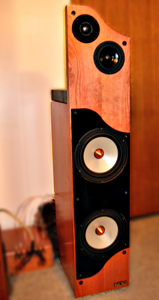
This brings us to the subject of this review: the Nola Viper References. A local dealer recommended that I try them out, so I did. The Vipers are floor standing speakers with an aluminum dome tweeter, a 4 1/2 ” mid and two 9” woofers. The two woofers are enclosed in their own sealed box with the 2” thick front baffle extending upwards into which the tweeter and midrange drivers are mounted.The backs of the tweeter and midrange are open to the air in an “open baffle” design. Claimed frequency response is 25 to 25,000 hertz, though no plus or minus figures are published .Impedance is said to be 8 ohms nominal, but dipping no lower than 4 ohms. That means they shouldn't present a difficult load to prospective amps. Good news for a reviewer.
At nearly four feet tall, these are a small to mid size floorstanders, going as deep as 15” with a width of 10”.The speakers are attractive with a satin cherry real wood finish. Overall craftsmanship is excellent. There are solid copper phase plugs in the woofers and the tops of the front baffles cut with an “S” curve similar to saloon doors with the tweeter diagonally inclined above the midrange towards the listener. They come with full grill covers, but look equally as picturesque without them. We are told there is a new high-gloss Piano Rosewood finish for no extra cost that also provides a more rigid cabinet structure - publisher
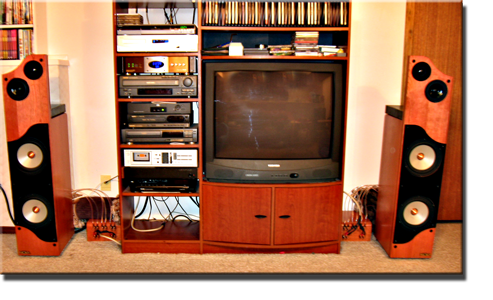
My current system consists of a Talk 3.1B Thunder CD Player and a BelCanto EVO2i gen 2 integrated amp connected with a balanced run of BlackMountain Pinnacle interconnects. These are copper and silver mixed, then gold plated and terminated with silver solder to Neutrix balanced connectors. These are both plugged into a Monster Power HTS 5100 Signature Line conditioner. Speaker cables are The Absolute Wire Force 4. They are directional and are made in Switzerland.
DESIGNING THE PERFECT SNAKE
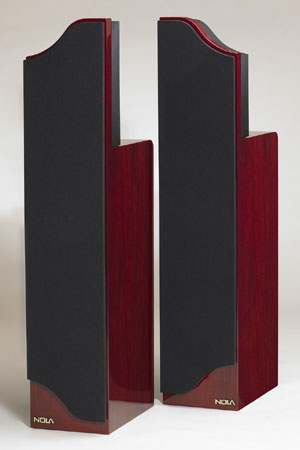
As always, I asked the head honcho and designer what his specific design goals were for this speaker. In this case, he is Carl Marchisotto, distinguished designer of speakers by Dahlquist and Acarian; “The design goal for the Viper Reference was to offer a “true reference” grade loudspeaker at an attainable price and with a modest footprint. Our goal, as with all the Nola speakers, is to provide as much of the same experience one gets from listening to a “live” musical event as we can arrange for the price. We feel the Viper Reference has sufficient resolution while remaining musical so as to serve as a true reference loudspeaker”. Hmmm. Sounds good so far.
Nola makes a cost-no-object statement speaker in the Grand Reference Mk IV Yours for only $145,000. In standard finish.
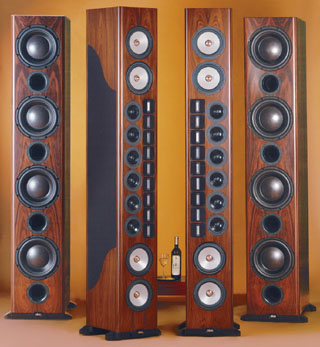
However, ninety-nine percent of all components and speakers are built to a price point and are not a cost-no-object effort, which means compromises and sacrifices must be made to reduce the price.
Mr. Marchisotto obviously had to make some critical decisions when he approached the Vipers at a fraction of the Grand Reference’s price. On that subject he told us, “We value mid range performance first. Compromises necessitated by cost and size constraints are generally relegated to the frequency extremes. We do not believe in extending bandwidth at the expense of mid range performance. Viper Reference does not extend as high or as low as either of the two models above it- Pegasus Reference Xtreme II or Grand Reference IV.1. However, driver unit quality in the Viper Reference is the same. The same Alnico mid range and Alnico tweeter is used in the Viper Reference. So you could say we compromised on quantity but not quality”.
As mentioned earlier, the Viper Reference employs a rather controversial design concept called “open baffle” for the mid and upper drivers. It’s a topic that is hotly debated in audio forums. As you might guess, open baffle means they are not enclosed at all and are free to do their things in open space. I asked Carl why he chose this concept; “The reason for the open baffle mid range and tweeter design is to eliminate enclosure coloration from the reproduction of the critical middle and high frequencies. We use proprietary drivers that we design to accomplish this as standard drivers are designed to be used in an enclosure. However we have come to the conclusion that it is not possible to completely eliminate mid range coloration caused by enclosures. This is despite what they are made of or how heavy they are. If you realize that if the front of a dynamic driver is producing an spl of 100 dB, then the rear of that same driver is also producing 100dB. It is not possible to completely absorb 100 dB inside a mid range enclosure. The sound that is not absorbed from the back of the cone is then reflected back through the cone at a later time-causing coloration of the initial sound. And then there is enclosure wall resonances - no material from this planet is completely dead. Even if it were, the laws of physics would have to be broken to eliminate all resonance since it is energy - publisher. There are also internal enclosure column resonances and standing waves to deal with. We preferred to design these problems out".
 In addition, it is said that drivers operating in free space and radiating in a 360 degree pattern also produce a more natural and large soundstage. Electrostat panels like Maggies and others do the same thing in a different way.
In addition, it is said that drivers operating in free space and radiating in a 360 degree pattern also produce a more natural and large soundstage. Electrostat panels like Maggies and others do the same thing in a different way.
Also a bit unconventional is the woofer system. Not only is it not open baffle, it is also not even ported; “We opted for a more accurate and tighter bass than is achieved with a ported design", explained Carl. "Also, the superior transient response of the sealed system provides less coloration of the critical mid range. The downside is that the sealed system is somewhat less efficient”.
Yet another unique feature of the Viper Reference shows how Carl thinks "outside the box". With this model he includes 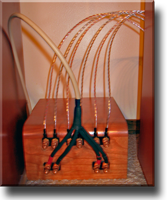 external crossovers, each housed in rich looking wooden boxes that exist outside the main speaker cabinets. These have double inputs for biwiring and three sets of copper five-way binding posts. Nola even supplies the cables with which to connect the external boxes, but they are not just any generic cables, they are Nordost Valhalla single filament silver wire, terminated with copper spades. Outboard crossovers are something not often found in a speaker in this price range. Of course, anything named “Nordost Valhalla” is even more rarely found in speakers at any price. You KNOW how much they cost! Isolating crossovers outside the speaker cabinets is said to reduce the effects of vibration and resonance inside the boxes where the drivers live, thus providing a more coherent and less degraded sound.
external crossovers, each housed in rich looking wooden boxes that exist outside the main speaker cabinets. These have double inputs for biwiring and three sets of copper five-way binding posts. Nola even supplies the cables with which to connect the external boxes, but they are not just any generic cables, they are Nordost Valhalla single filament silver wire, terminated with copper spades. Outboard crossovers are something not often found in a speaker in this price range. Of course, anything named “Nordost Valhalla” is even more rarely found in speakers at any price. You KNOW how much they cost! Isolating crossovers outside the speaker cabinets is said to reduce the effects of vibration and resonance inside the boxes where the drivers live, thus providing a more coherent and less degraded sound.
Carl was anxious to point out that he uses rather pricey and hard to acquire Alnico magnets for the mid and high drivers. Alnicos are some of the most powerful magnets on the planet, made so in part because they employ cobalt as a main ingredient. Carl told me cobalt is not as readily available or inexpensive as standard magnets, but they help contribute to his speaker's unique and superior performance.
THE VIPERS STRIKE

On first listen after proper burn in, these speakers sounded a bit rolled off on the top end and loose on the bottom. However, my sitting position on my couch is low, so I put 3 washers between the rear spikes and the bottom of the speakers to tilt the speaker slightly forward. This restored the proper balance to the top end. Once that was fixed, I focused on fixing the bottom end.
The dealer suggested that I bring them out into the room away from the wall, but that was not the solution. The other thing he mentioned was, even at a stated 89 db static efficiency, the Vipers like lots of power. So I tried a Bryston 4B SST, but this did not fix the issue either. The last thing he suggested was placing absorbing cushions behind each speaker. I moved the speakers back so that the front baffle was 26” from the wall and placed a single bedroom pillow on the floor behind each one. I toed-in the speakers five degrees and found that this fixed the bass problem. The only complaint I have is that the speakers are not heavy enough for proper anchoring through carpet using the provided spikes. I made 2” thick steel plates the same size as the top of the woofer enclosure, painted them black and set them on a 1/8” thick sheet of rubber on the speaker to mass-load the enclosure. At this point I began critical listening.
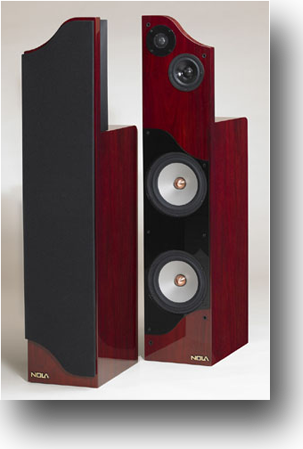 The top end seemed natural and clean. Now we're talking! Detail in the top end is good without any prominence in any region. The mids are well defined and blend well with the woofers. The bottom end is authoritative and full, no subwoofer needed here. The overall tonal balance is natural and properly scaled. To me, scaling and tonal balance are paramount. Instruments and voices need to be sized appropriately in relation to the recording and to each other; nothing exaggerated or minimized. For example, when a large instrument such as an acoustic bass is played, it should “look” real with proper body and not too big or too small.
The top end seemed natural and clean. Now we're talking! Detail in the top end is good without any prominence in any region. The mids are well defined and blend well with the woofers. The bottom end is authoritative and full, no subwoofer needed here. The overall tonal balance is natural and properly scaled. To me, scaling and tonal balance are paramount. Instruments and voices need to be sized appropriately in relation to the recording and to each other; nothing exaggerated or minimized. For example, when a large instrument such as an acoustic bass is played, it should “look” real with proper body and not too big or too small.
This speaker also sounds coherent and whole, not like the instruments were chopped up and spit out. There is a certain rightness about the sound that leads you to believe that you are listening to real instruments and not just a speaker.
Another area where the Nolas excel is soundstaging and imaging, perhaps due to the that open baffle design. I even prefer this aspect of the Vipers over the much more costly Wilson/Watt Puppies which I spent quite a bit of time with in the showroom. The Viper’s soundstage is deep and wide with a delightful journey into realism.
One of Carl’s stated design goals was to convey a sense of realism in all his speakers. Even though these are not particularly large speakers, I believe he has met his goal in that regard. In so doing, he certainly achieved a high level of satisfaction in this reviewer.
 The imaging is superior with excellent specificity. One of my favorite recordings for checking soundstaging and imaging is Patricia Barber’s Cafe Blue. Most other recordings sound flat in comparison. Her unique rich alto, devoid here of typical studio effects and gimmickry, was rendered near flawlessly.
The imaging is superior with excellent specificity. One of my favorite recordings for checking soundstaging and imaging is Patricia Barber’s Cafe Blue. Most other recordings sound flat in comparison. Her unique rich alto, devoid here of typical studio effects and gimmickry, was rendered near flawlessly.
It came as no surprise then when Carl later said, “We use the human voice as the ultimate guide to mid range accuracy. However, we are not just talking about spectral balance here but also the spatial characteristics imparted to the sound of a voice by humans. This 3 dimensional imaging of voices and instruments is something we particularly strive for in our designs and in this area the Nola Viper Reference is not compromised. We do not specifically design for soundstaging. This, however, is a natural outgrowth of the good timbrel accuracy and low diffraction of the design”.
To summarize, for me these speakers recreate the magic of the original event. I think these are keepers, no doubt about it. That’s not mere hyperbole, I put my money where my writing is and purchased these - at full retail, I might add. Now I understand why so many companies at CES were using Nolas to make their electronics shine.

Needless to say, since I forked over my own hard earned bucks, I believe others may find this speaker appealing as well. The Nola Viper Reference is as advertised - a reference quality speaker at a mid-level speaker price. Carl Marchisotto has created a speaker where very few corners have been cut and state of the art features are abundant - a model of how to design a speaker to a specific pricepoint. However, it’s not for everybody. They do demand sufficient power to fill a large room, at least a good 100 watts per channel, so SET and low power mavens should proceed with caution. They also need some breathing room, so larger rooms would be friendlier. (That's why Nola makes smaller speakers). In addition, bad sounding recordings have nowhere to hide. The Nola Viper References will reward good sources and spank those whose engineers or pressing plants were not so diligent. Those who desire a bit more forgiving presentation can easily accomplish that without sacrificing the speaker's excellent character through judicious choices of players and speaker leads, but if you change your mind in favor of supreme accuracy, these Vipers will be waiting, just lying in wait for you.
Web link = www.nolaspeakers.com
Specifications
Response: 25 Hz to 25,000 Hz
Low Frequency: Twin cast magnesium 220mm bass drivers, sealed system
Mid Frequency: 110mm tri-laminate cone with Alnico magnet
High Frequency: 25mm dipole dome with twin Alnico magnets
Impedance: 8 ohm nominal / 4 ohm minimum
Crossover: External bi-wire Dimensions: 46"H x 10"W x 15"
Finish: Piano Rosewood (standard), Piano Black (optional)